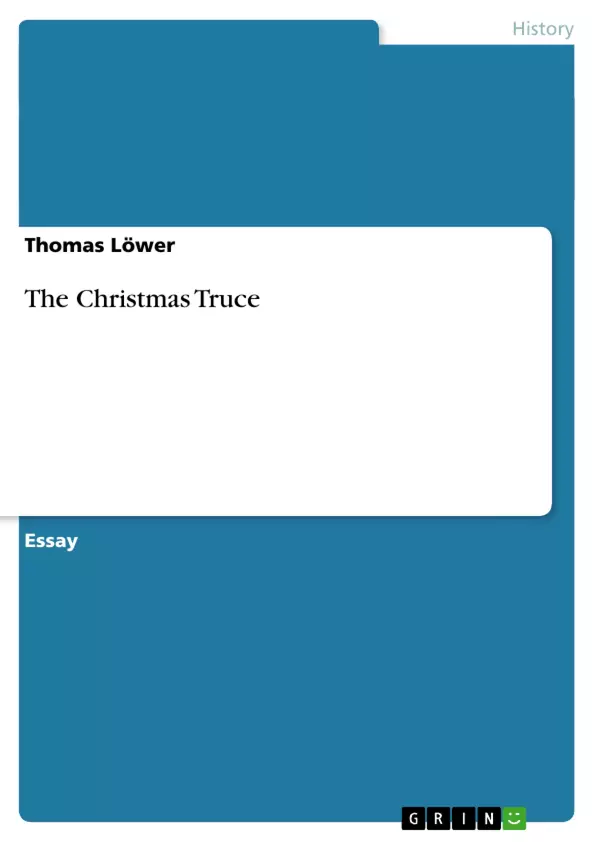“But, however, looking back on it all, I wouldn’t have missed that unique
and weird Christmas Day for anything.”1
The English soldier Bruce Bairnsfather looked back on an event in which he had
taken part. This small excerpt shows quite clearly that something extraordinary and
unexpected must have happened. Bairnsfather talks about the Christmas Truce, which
happened in 1914. After almost six month of war, soldiers fighting for the Entente powers
and soldiers fighting for the “Mittelmächte” met in No Man’s Land and celebrated
Christmas together. The soldiers exchanged gifts, sometimes addresses, and drank
together. Often the truce started with a request to bury the dead comrades lying between
the trenches. The Christmas Truce was a small peaceful episode in a cruel environment.
Certainly, Bairnsfather’s statement is a bit too generalized because it did not occur along
the whole frontline. Mostly English and German soldiers took part in the Christmas
fraternization, but also in some cases French, Belgian, Austrian and Russian soldiers took
part.2 In the following years the Christmas Truce was mystified as an act of humanity in
an inhuman war. Jorgensen and Harrison-Lever published a picture book for children with
the Christmas Truce as the background. A young soldier sees a nice colored small bird
which was captured in barbed wire. He decides to leave his trench to free the bird, and no
enemy shoots at him. The publisher’s text on the back introduces this book with the words: [...]
1 Bairnsfather, Bruce. Bullets & Billets, (New York: G.P. Putnam’s Sons, 1917), 69.
2 Ekstein, Modris. Rites of Spring. The Great War and the Birth of the Modern Age, (Boston/New York: First
Mariner Books, 2000), 109-114.
Inhaltsverzeichnis (Table of Contents)
- The Christmas Truce 1914
- The Mystification of the Christmas Truce
- A Question of Propaganda
- Stereotypes in the Propaganda War
- The Soldiers' Opinions
Zielsetzung und Themenschwerpunkte (Objectives and Key Themes)
This paper examines the Christmas Truce of 1914 within the context of the Propaganda War. It investigates whether the propaganda of the warring states influenced the soldiers who participated in the truce, and if so, in what ways. The study seeks to determine if the soldiers were influenced by propaganda and whether their opinions about their opponents in the trenches changed as a result.
- The nature and impact of propaganda during World War I
- The role of stereotypes in shaping perceptions of the enemy
- The Christmas Truce as a manifestation of both humanity and the influence of propaganda
- The relationship between propaganda and the soldiers' attitudes towards their opponents
- The significance of the Christmas Truce as a historical event and its relevance to understanding the complexities of war
Zusammenfassung der Kapitel (Chapter Summaries)
- The Christmas Truce 1914: This chapter introduces the Christmas Truce of 1914, describing the event and its significance. It examines the historical context and the factors that contributed to its occurrence, including the desire for peace and the influence of religious appeals. It also explores the contrasting views on the truce, highlighting both its positive aspects and its potential for romanticization.
- The Mystification of the Christmas Truce: This chapter analyzes the various ways in which the Christmas Truce was mystified after the war. It focuses on how the event was portrayed as an act of humanity in an inhuman war, often through the use of idealized narratives and fictional accounts. It also examines the romanticized aspects of the truce, such as the popular image of soldiers playing football together.
- A Question of Propaganda: This chapter introduces the primary focus of the paper: the impact of propaganda on the Christmas Truce. It outlines the central questions of the study, investigating whether propaganda influenced the soldiers' actions and their perceptions of the enemy. It establishes the framework for analyzing the role of propaganda in shaping the events of the truce.
- Stereotypes in the Propaganda War: This chapter delves into the specific stereotypes created by the propaganda departments of the warring states. It examines the negative portrayals of the enemy in the propaganda campaigns, focusing on the specific examples of the anti-British propaganda disseminated by the German government. This section relies heavily on secondary literature, such as Read's book Atrocity Propaganda 1914-1919 and Roeter's book The Art of Psychological Warfare.
- The Soldiers' Opinions: This chapter explores the soldiers' own perceptions of the enemy and their experiences during the truce. It draws on primary sources, including letters from soldiers who participated in the truce, to provide insights into their personal attitudes and how they reacted to the propaganda. The chapter also references key books on the truce, such as Weintraub's Silent Night and Brown's Christmas Truce.
Schlüsselwörter (Keywords)
The key terms and topics explored in this paper include the Christmas Truce of 1914, Propaganda War, stereotypes, World War I, soldier attitudes, enemy perception, and the impact of propaganda on historical events. The study utilizes primary sources, such as letters from soldiers, and secondary literature, such as books and articles on propaganda and the Christmas Truce.
- Citation du texte
- Thomas Löwer (Auteur), 2003, The Christmas Truce, Munich, GRIN Verlag, https://www.grin.com/document/28872



